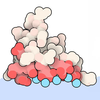[English] 日本語
 Yorodumi
Yorodumi- PDB-3hk6: Crystal structure of murine thrombin mutant W215A/E217A (two mole... -
+ Open data
Open data
- Basic information
Basic information
| Entry | Database: PDB / ID: 3hk6 | ||||||
|---|---|---|---|---|---|---|---|
| Title | Crystal structure of murine thrombin mutant W215A/E217A (two molecules in the asymmetric unit) | ||||||
 Components Components |
| ||||||
 Keywords Keywords | HYDROLASE / Serine protease / Acute phase / Blood coagulation / Calcium / Cleavage on pair of basic residues / Disulfide bond / Gamma-carboxyglutamic acid / Glycoprotein / Kringle / Protease / Zymogen | ||||||
| Function / homology |  Function and homology information Function and homology informationCommon Pathway of Fibrin Clot Formation / Platelet Aggregation (Plug Formation) / Gamma-carboxylation of protein precursors / Transport of gamma-carboxylated protein precursors from the endoplasmic reticulum to the Golgi apparatus / Intrinsic Pathway of Fibrin Clot Formation / Removal of aminoterminal propeptides from gamma-carboxylated proteins / Peptide ligand-binding receptors / Thrombin signalling through proteinase activated receptors (PARs) / Regulation of Complement cascade / G alpha (q) signalling events ...Common Pathway of Fibrin Clot Formation / Platelet Aggregation (Plug Formation) / Gamma-carboxylation of protein precursors / Transport of gamma-carboxylated protein precursors from the endoplasmic reticulum to the Golgi apparatus / Intrinsic Pathway of Fibrin Clot Formation / Removal of aminoterminal propeptides from gamma-carboxylated proteins / Peptide ligand-binding receptors / Thrombin signalling through proteinase activated receptors (PARs) / Regulation of Complement cascade / G alpha (q) signalling events / Cell surface interactions at the vascular wall / cytolysis by host of symbiont cells / thrombospondin receptor activity / thrombin / thrombin-activated receptor signaling pathway / negative regulation of astrocyte differentiation / positive regulation of phospholipase C-activating G protein-coupled receptor signaling pathway / neutrophil-mediated killing of gram-negative bacterium / ligand-gated ion channel signaling pathway / positive regulation of collagen biosynthetic process / positive regulation of blood coagulation / regulation of cytosolic calcium ion concentration / fibrinolysis / negative regulation of proteolysis / negative regulation of cytokine production involved in inflammatory response / positive regulation of release of sequestered calcium ion into cytosol / acute-phase response / lipopolysaccharide binding / positive regulation of insulin secretion / platelet activation / positive regulation of protein localization to nucleus / positive regulation of reactive oxygen species metabolic process / antimicrobial humoral immune response mediated by antimicrobial peptide / peptidase activity / regulation of cell shape / heparin binding / : / regulation of gene expression / positive regulation of cell growth / endopeptidase activity / cell surface receptor signaling pathway / positive regulation of phosphatidylinositol 3-kinase/protein kinase B signal transduction / G protein-coupled receptor signaling pathway / receptor ligand activity / external side of plasma membrane / serine-type endopeptidase activity / positive regulation of cell population proliferation / calcium ion binding / proteolysis / extracellular space Similarity search - Function | ||||||
| Biological species |  | ||||||
| Method |  X-RAY DIFFRACTION / X-RAY DIFFRACTION /  MOLECULAR REPLACEMENT / Resolution: 3.2 Å MOLECULAR REPLACEMENT / Resolution: 3.2 Å | ||||||
 Authors Authors | Gandhi, P.S. / Page, M.J. / Chen, Z. / Bush-Pelc, L. / Di Cera, E. | ||||||
 Citation Citation |  Journal: J.Biol.Chem. / Year: 2009 Journal: J.Biol.Chem. / Year: 2009Title: Mechanism of the Anticoagulant Activity of Thrombin Mutant W215A/E217A. Authors: Gandhi, P.S. / Page, M.J. / Chen, Z. / Bush-Pelc, L. / Di Cera, E. #1:  Journal: J.Biol.Chem. / Year: 2004 Journal: J.Biol.Chem. / Year: 2004Title: The anticoagulant thrombin mutant W215A/E217A has a collapsed primary specificity pocket. Authors: Pineda, A.O. / Chen, Z.W. / Caccia, S. / Cantwell, A.M. / Savvides, S.N. / Waksman, G. / Mathews, F.S. / Di Cera, E. | ||||||
| History |
|
- Structure visualization
Structure visualization
| Structure viewer | Molecule:  Molmil Molmil Jmol/JSmol Jmol/JSmol |
|---|
- Downloads & links
Downloads & links
- Download
Download
| PDBx/mmCIF format |  3hk6.cif.gz 3hk6.cif.gz | 130.7 KB | Display |  PDBx/mmCIF format PDBx/mmCIF format |
|---|---|---|---|---|
| PDB format |  pdb3hk6.ent.gz pdb3hk6.ent.gz | 103.3 KB | Display |  PDB format PDB format |
| PDBx/mmJSON format |  3hk6.json.gz 3hk6.json.gz | Tree view |  PDBx/mmJSON format PDBx/mmJSON format | |
| Others |  Other downloads Other downloads |
-Validation report
| Arichive directory |  https://data.pdbj.org/pub/pdb/validation_reports/hk/3hk6 https://data.pdbj.org/pub/pdb/validation_reports/hk/3hk6 ftp://data.pdbj.org/pub/pdb/validation_reports/hk/3hk6 ftp://data.pdbj.org/pub/pdb/validation_reports/hk/3hk6 | HTTPS FTP |
|---|
-Related structure data
| Related structure data |  3hk3C 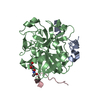 3hkiC 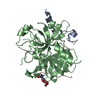 3hkjC 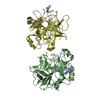 1tq0S S: Starting model for refinement C: citing same article ( |
|---|---|
| Similar structure data |
- Links
Links
- Assembly
Assembly
| Deposited unit | 
| ||||||||
|---|---|---|---|---|---|---|---|---|---|
| 1 | 
| ||||||||
| 2 | 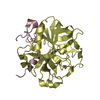
| ||||||||
| Unit cell |
| ||||||||
| Details | THE BIOLOGICAL ASSEMBLY CONSISTS OF A AND B CHAINS. |
- Components
Components
| #1: Protein/peptide | Mass: 5105.731 Da / Num. of mol.: 2 / Fragment: Light chain: UNP residues 317-360 Source method: isolated from a genetically manipulated source Source: (gene. exp.)   #2: Protein | Mass: 29795.461 Da / Num. of mol.: 2 / Fragment: Heavy chain: UNP residues 361-618 / Mutation: W215A, E217A Source method: isolated from a genetically manipulated source Source: (gene. exp.)   Has protein modification | Y | |
|---|
-Experimental details
-Experiment
| Experiment | Method:  X-RAY DIFFRACTION / Number of used crystals: 1 X-RAY DIFFRACTION / Number of used crystals: 1 |
|---|
- Sample preparation
Sample preparation
| Crystal | Density Matthews: 2.6 Å3/Da / Density % sol: 52.71 % |
|---|---|
| Crystal grow | Temperature: 295 K / Method: vapor diffusion, hanging drop / pH: 4.6 Details: 200mM Ammonium dihydrogen phosphate, 14% PEG 3350, pH 4.6, VAPOR DIFFUSION, HANGING DROP, temperature 295K |
-Data collection
| Diffraction | Mean temperature: 100 K |
|---|---|
| Diffraction source | Source: SEALED TUBE / Type: MACSCIENCE / Wavelength: 1.54178 Å |
| Detector | Type: MAR scanner 345 mm plate / Detector: IMAGE PLATE / Date: May 14, 2009 / Details: mirrors |
| Radiation | Protocol: SINGLE WAVELENGTH / Monochromatic (M) / Laue (L): M / Scattering type: x-ray |
| Radiation wavelength | Wavelength: 1.54178 Å / Relative weight: 1 |
| Reflection | Resolution: 3.2→40 Å / Num. all: 13077 / Num. obs: 12201 / % possible obs: 93.3 % / Observed criterion σ(I): -1 / Redundancy: 6.6 % / Rmerge(I) obs: 0.105 / Net I/σ(I): 14.6 |
| Reflection shell | Resolution: 3.2→3.26 Å / Redundancy: 5.1 % / Rmerge(I) obs: 0.378 / Mean I/σ(I) obs: 3.5 / Num. unique all: 437 / % possible all: 72.8 |
- Processing
Processing
| Software |
| |||||||||||||||||||||||||||||||||||||||||||||||||||||||||||||||||
|---|---|---|---|---|---|---|---|---|---|---|---|---|---|---|---|---|---|---|---|---|---|---|---|---|---|---|---|---|---|---|---|---|---|---|---|---|---|---|---|---|---|---|---|---|---|---|---|---|---|---|---|---|---|---|---|---|---|---|---|---|---|---|---|---|---|---|
| Refinement | Method to determine structure:  MOLECULAR REPLACEMENT MOLECULAR REPLACEMENTStarting model: PDB entry 1TQ0 Resolution: 3.2→40 Å / Cor.coef. Fo:Fc: 0.9 / Cor.coef. Fo:Fc free: 0.803 / SU B: 27.591 / SU ML: 0.489 / Isotropic thermal model: Isotropic / Cross valid method: THROUGHOUT / σ(F): 0 / σ(I): 0 / ESU R Free: 0.679 / Stereochemistry target values: MAXIMUM LIKELIHOOD
| |||||||||||||||||||||||||||||||||||||||||||||||||||||||||||||||||
| Solvent computation | Ion probe radii: 0.8 Å / Shrinkage radii: 0.8 Å / VDW probe radii: 1.4 Å / Solvent model: MASK | |||||||||||||||||||||||||||||||||||||||||||||||||||||||||||||||||
| Displacement parameters | Biso mean: 44.848 Å2
| |||||||||||||||||||||||||||||||||||||||||||||||||||||||||||||||||
| Refinement step | Cycle: LAST / Resolution: 3.2→40 Å
| |||||||||||||||||||||||||||||||||||||||||||||||||||||||||||||||||
| Refine LS restraints |
| |||||||||||||||||||||||||||||||||||||||||||||||||||||||||||||||||
| LS refinement shell | Resolution: 3.2→3.28 Å / Total num. of bins used: 20
|
 Movie
Movie Controller
Controller




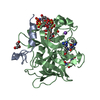
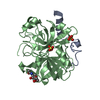


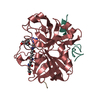

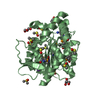
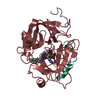
 PDBj
PDBj








